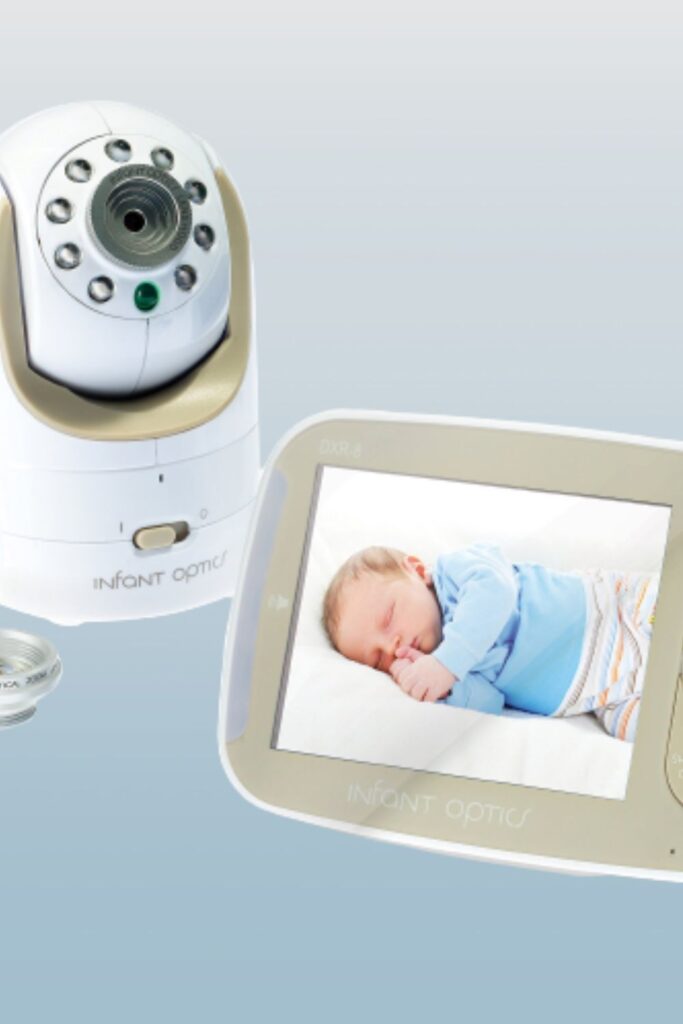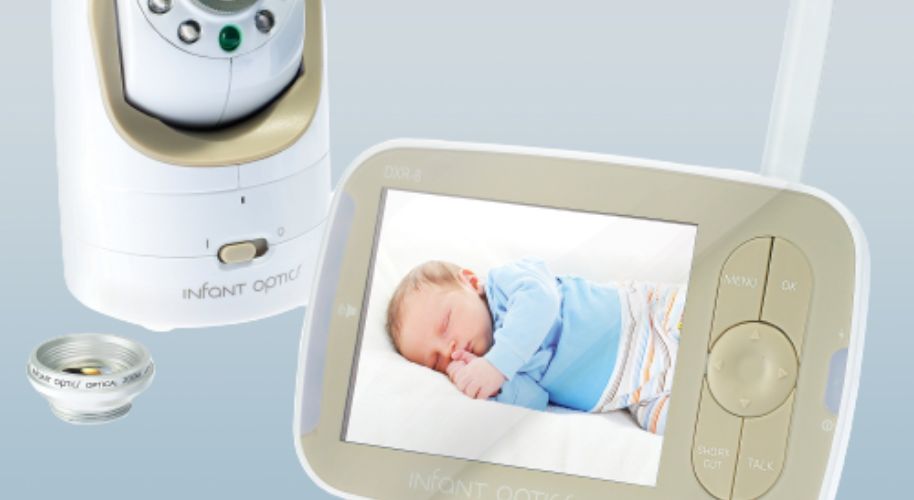Last Updated on June 5, 2025
Every parent wants to ensure their child’s comfort and safety, but sometimes, technicalities can get in the way. One such instance is the Infant Optics Monitor, a popular choice among parents for its reliability and comprehensive features.
Among these features is the ability to display room temperature, a critical element in maintaining an ideal environment for your little one. However, the default temperature reading is in Celsius, which may only be convenient for some.
If you’ve ever wondered how to change the temperature display from Celsius to Fahrenheit or adjust the temperature settings on your Infant Optics Monitor, you’ve come to the right place. This blog post will guide you through the process, ensuring that monitoring your baby’s surroundings becomes a breeze.

Step-By-Step, Infant Optics Change Temp
The Infant Optics Monitor is a popular baby monitoring device with a temperature feature. This function allows you to monitor the temperature in your baby’s room, ensuring it stays within a comfortable range. The default temperature setting is Celsius, but it can be changed to Fahrenheit. Here’s how you do it:
- Ensure that the Infant Optics Monitor is plugged in and turned on.
- Once the monitor is on, locate the temperature display on the screen and press the ‘Menu’ button.
- Hold the ‘Menu’ button for 2 seconds to enter the menu.
- Press the left or right button until you see the Temp icon.
- After locating the temperature settings, select the option to switch your monitor from Celsius to Fahrenheit.
- Hold the shortcut button for three seconds if you want to toggle between Celsius and Fahrenheit quickly.
Please note that while the Infant Optics Monitor provides valuable data about your baby’s environment, it doesn’t replace the need for regular check-ins with your baby.
Changing the Temperature on the Infant Optics Monitor
The Infant Optics Monitor allows you to monitor the temperature of your baby’s room, but it doesn’t allow you to change or control the actual temperature. The device has a built-in temperature sensor that displays the current room temperature on the screen.
However, if what you want is to change the temperature display from Celsius to Fahrenheit or vice versa, here’s how you can do it:
- Make sure the Infant Optics Monitor is turned on.
- Press the ‘Menu’ button on the front panel of the monitor.
- Hold the ‘Menu’ button for 2 seconds to enter the menu.
- Use the left or right buttons to navigate the menu until you find the ‘Temperature Unit’ option.
- Once you’ve located the ‘Temperature Unit,’ select it, and you can switch the temperature display from Celsius to Fahrenheit.
If you want to change the temperature in your baby’s room, you must adjust your home’s heating or cooling system or use a separate heater or fan.
You Might also Like These Resources!
- Changing Diapers When Your Baby Keeps Rolling
- Connecting Your Nanit Baby Monitor to WiFi
- Removing Crayon Marks from Plastic Toys
Why Need to Change Temp on Infant Optics Monitor?

Changing the temperature display on an Infant Optics Monitor doesn’t change the actual temperature in the room, but it can help you better understand and monitor your baby’s environment. Here are some reasons why you might want to change the temperature display on your Infant Optics Monitor:
Understanding room conditions:
The Infant Optics Monitor has a built-in temperature sensor that displays the current room temperature on the screen. This can help you ensure that your baby’s room is at a comfortable and safe temperature. According to the American Academy of Pediatrics, the ideal room temperature for a baby’s room is between 68–72°F (20–22.2°C). If the temperature in your baby’s room falls outside this range, it could be uncomfortable or unsafe.
Converting units:
The monitor allows you to switch the temperature display from Celsius to Fahrenheit or vice versa. Depending on your familiarity with these temperature scales, switching to the one you’re more comfortable with can make it easier to understand whether the room is at an appropriate temperature quickly.
Maintaining an optimal sleep environment:
Research has shown that cooler temperatures can promote better sleep. Parents can adjust their home’s heating or cooling by monitoring the temperature to create the best sleep environment for their baby.
Remember, Infant Optics Monitor provides a temperature display. It does not allow you to control or adjust the actual temperature in the room.
What are the benefits of switching to Fahrenheit?
Switching to Fahrenheit as your temperature scale might have several benefits depending on your circumstances and needs:
Familiarity
If you’re more familiar with the Fahrenheit scale, it can make interpreting temperatures quicker and easier. This is particularly true in countries like the United States, where Fahrenheit is the standard temperature measurement unit.
Precision
The Fahrenheit scale has 180 intervals between the freezing and boiling points of water (32°F to 212°F), compared to 100 intervals in Celsius (0°C to 100°C). This can allow for more precise measurements without resorting to fractional degrees, which can be useful in weather forecasting or room temperature.
Sub-Zero Temperatures
In Fahrenheit, temperatures below freezing (below 32°F) are denoted by negative numbers, which can provide a quick visual indicator that conditions are below freezing. In Celsius, freezing occurs at 0°C, so negative temperatures aren’t as immediately obvious.
Comfort Ranges
Many people find Fahrenheit more intuitive for everyday weather and indoor temperature ranges. For instance, 0°F to 100°F covers approximately the range of weather most people will experience, from very cold to extremely hot weather.
However, knowing that these benefits largely depend on what you’re accustomed to is important. If you’ve grown up using Celsius, you may not find these benefits compelling enough to switch to Fahrenheit.
FAQs
What is the ideal room temperature for a baby’s room?
The American Academy of Pediatrics recommends a temperature of 68–72°F (20–22.2°C).
Does the Infant Optics Monitor show negative temperatures?
The monitor can display negative temperatures if the room’s temperature falls below freezing.
Can the Infant Optics Monitor alert me if the room temperature is too high or low?
Yes, the monitor has an alarm function for when the temperature goes outside a set range.
Can I use the Infant Optics Monitor outdoors to monitor the temperature?
The monitor is intended for indoor use. Outdoor use may damage the device.
Conclusion
While unable to control room temperature, the Infant Optics Monitor provides a valuable tool for parents to monitor their baby’s environment. It enables you to switch display units between Fahrenheit and Celsius based on your preference, ensuring you can quickly understand whether your baby’s room is comfortable and safe.
Remember, this monitor is designed for indoor use and provides a general idea of the room temperature. For more precise measurements or to control room temperatures, consider additional devices like a separate thermometer or a home heating/cooling system.
You Might Also Like These Latest Content!
- Putting On the Owlet Sock: Step-By-Step Guide
- Crafting Scribble Scrubbie Color Drops
- Preventing Clicking Sounds During Bottle Feeding

Amy A. Vincent is a Certified Pediatric Sleep Consultant and a mother of three beautiful children. She helps parents transition their babies from swing sleep to safe, independent sleep. She is passionate about helping parents teach their children the skills needed to become good sleepers and aims to make the process as easy and stress-free as possible. Read more
